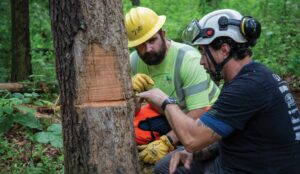
If treated well, your electric co-op’s equipment and infrastructure-poles, lines, transformers, and the like-can last for decades. But as useful life ends for these components, reliability becomes more of an issue and co-ops are increasingly turning to innovative technologies to keep service reliable, safe and affordable.
“Electric cooperatives have been leaders in adopting technologies to improve reliability and keep costs contained,” says Brian Sloboda, senior program manager with the Cooperative Research Network, an arm of the Arlington, Va.-based National Rural Electric Cooperative Association (NRECA).
A good example involves system automation, a set of devices and software programs that allows utilities to track the flow of electricity in near real time. Co-ops are leading the way in deploying and testing these devices, due to their potential to boost efficiency, reliability and cost savings.
Sloboda offers down-line automation (DLA) as a prime example. Rather than wait for an outage report to be called in, DLA can detect a problem (such as a tree branch touching a line) as it occurs and possibly fix it remotely by rerouting power sometimes before an outage even occurs.
“The goal of DLA is to decrease the duration of an outage and reduce the number of people who experience it,” Sloboda explains.
Another useful technology, called automatic vehicle location, or AVL, allows a dispatcher at co-op headquarters to track service trucks and what equipment each truck carries. This comes in handy when a trouble report comes in. The dispatcher can route the nearest truck that has the right parts or tools to the problem site. AVL saves time, fuel and potential slow downs. AVL systems help determine the optimal route to jobs and a co-op dispatcher can easily see which lineman is close to a new outage or job site.
Co-ops are also becoming more sophisticated with geographic information systems (GIS). With GIS electronic mapping programs, a co-op can log in every asset across its service territory, and its exact location and age are available to any lineman with a GIS map on their mobile computer. GIS also helps in emergency situations, such as a storm or car accident, by showing poles, wire sizes, and equipment used at each location. This allows a co-op to send correct replacement materials.
“Anybody who’s had a dishwasher repairman come all the way to your house and finds he has the wrong parts can understand this,” Sloboda relates. “By having everything in your mapping system, you get it right the first time.”
Proliferation of smart meters
Digital “smart” meters have already been installed at the majority of Illinois electric cooperatives. Analog spinning disc meters are being replaced with “smart” models by the millions—52 million nationwide have been installed by all utilities as of the end of last year, according to market research. Nationwide 25 percent of electric co-ops have installed advanced metering infrastructure, while seven percent of investor-owned utilities and four percent of municipal utilities have installed the new smart meters according to a Federal Energy Regulatory Commission survey.

Smart meters use two-way communications to transmit meter readings, sometimes hourly, to a co-op. This data offers more accurate reads and can allow co-ops to pinpoint spikes or dips in energy consumption, providing a boon for energy auditors. The new meters can also monitor power quality like voltage levels at the meter, track blinking light issues and help a co-op determine the scope and location of outages.
Smart meters require a communications network, just like a computer network in a business. All of the smart meter installations at Illinois electric co-ops utilize the power lines for the communications network back to substation nodes. From the substations, however, a broadband connection is necessary. In some cases several Illinois co-ops have built their own wireless broadband network to fill this communications gap. The side benefit has been the expansion of rural broadband service to members and non-members in the rural areas served by these co-ops.
What’s next?
Smart meters also open the door for consumers to better control their electricity use. Through in-home displays that respond to price signals, online portals that show meter readings with tips on how to use less, and the opportunity to participate in demand-response programs, co-op members can use electricity more efficiently and help their not-for-profit electric providers delay the need to buy additional power or construct new generating plants.
“Electric co-ops were created because there was a need that wasn’t being met, and rural people took it upon themselves to get the job done,” says Duane Noland, President/CEO of the Association of Illinois Electric Cooperatives. “That pioneering spirit still exists. We’re on the forefront of technological advancements, and we will continue to work hard so our members’ needs are met. Reliable, affordable, safe electric power—that’s what it’s all about.”
Sources: Cooperative Research Network, NRECA Strategic Analysis, U.S. Energy Information Administration, IHS
Magen Howard writes on consumer and cooperative affairs for the National Rural Electric Cooperative Association, the Arlington, Va.-based service arm of the nation’s 900-plus consumer-owned, not-for-profit electric cooperatives. Angela Perez contributed to this article.









